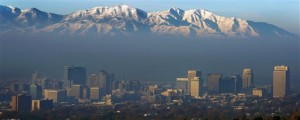
Amanda Smith, executive director for the Utah Department of Environmental Quality, laid out the facts facing the state and their current environmental condition as she sat staring down the 20-plus representatives for the Natural Resources, Agriculture and Environment Committee in the Utah Capitol Building.
Ranging from employee outsourcing, water quality, land conditions and especially air pollution, Amanda took up most of the meeting discussing the issues Utah is currently encountering. According to Smith, the department has to deal with more regulations than ever before and is forced to do so on a budget that is already thin.
This comes about a month after Gov. Gary Herbert signed eight new bills into laws designed to improve the air quality in Utah. The laws will increase the number of electrical vehicle charging stations, help homeowners change heating sources from wood-burning stoves, increase benefits for use of cleaner biodiesel fuels and provide tax credits for energy efficient vehicles.
It also enacted a Tier III gasoline initiative that will reduce pollution from cars and trucks by eliminating high amounts of sulfur and reducing emissions by up to 80 percent.
According to epa.gov, “Over 149 million Americans are currently experiencing unhealthy levels of air pollution, which are linked with adverse health impacts such as hospital admissions, emergency room visits, and premature mortality. Motor vehicles are a particularly important source of exposure to air pollution, especially in urban areas.”
The Environmental Protection Agency also says a nationwide Tier III movement would be equal to taking 33 million cars off the road and estimates that in 2030 the annual monetized health benefits of the Tier III standards will be between $6.7 and $19 billion.
“With all of these new statutes dictating our resources we need more support,” Smith said. “The EPA has done a study that shows that of all the places in the United States that would benefit air quality-wise from Tier III gasoline, that the counties along the Wasatch Front would benefit more greatly than anywhere else in the country.”
The problem with Utah pollution doesn’t start and end with motorized vehicles, however. Smith also explained that the refineries in Utah (which put out most of the pollution) are allowed to balance out their emissions with their branches all over the country, which puts Utah and its small refineries on the back burner due to the ineffective costs of upgrading the smaller-sized facilities here.
“Along the Wasatch Front, these refineries are in desperate need of all the upgrades they can manage,” said Sen. Jim Dabakis, D-Salt Lake City.
Advocacy groups like Breathe Utah are still hoping that eventually Utah will pass a law that will allow the state to set its own air-quality standards beyond those of the federal government and force the refineries to upgrade to stay operational.




